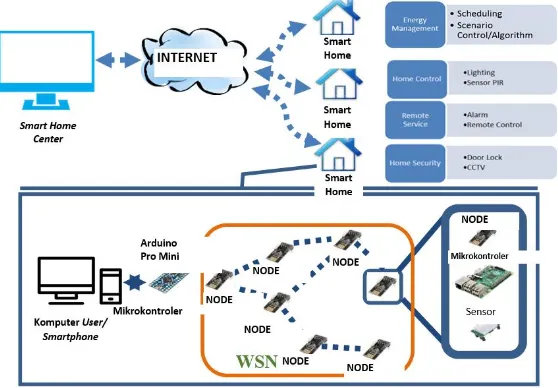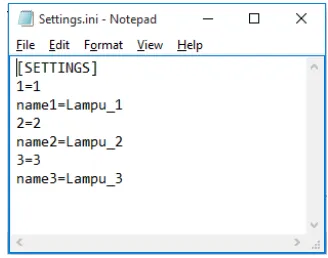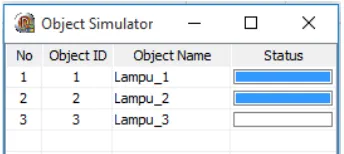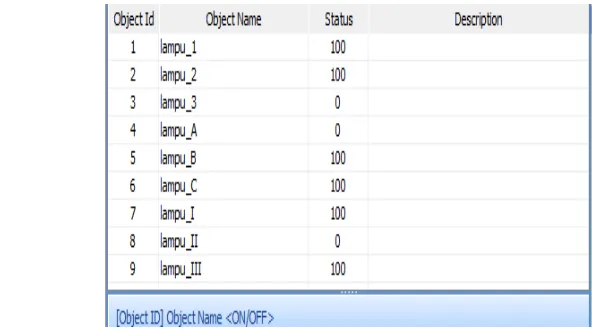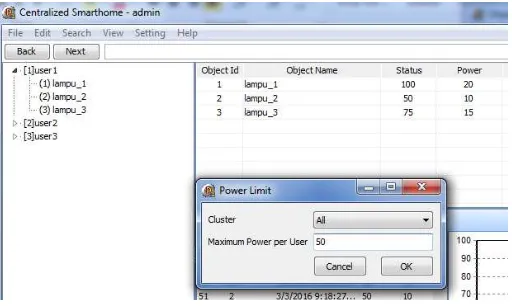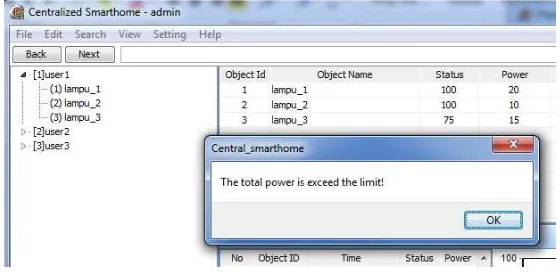Journal of Information Technology and Computer Science Volume 1, Number 2, 2016, pp. 98-107
Journal Homepage: www.jitecs.ub.ac.id
Centralized Smart Home Framework Monitoring for Power
Savings
Gembong Edhi Setyawan1, Agung Setiabudi2, Adharul Muttaqin3, Mochammad Hannats Hanafi Ichsan4
Faculty of Computer Science, University of Brawijaya. 8 Veteran Road, Malang, Indonesia, 65145
1gembong@ub.ac.id,2agungsetiabudi@ub.ac.id,3adharul@ub.ac.id, 4hanas.hanafi@ub.ac.id
Received 17 November 2016; accepted 31 December 2016
Abstract. Electrical energy has become a staple for humans. Almost all human activities always require electrical energy. To maintain the availability of electricity at any time, then it takes the process of global electricity savings. The electricity savings can be done in two ways, the first is the development of technology to make electric appliances that require low power for operation and the second is to improve human behavior in the use of electrical appliances (turning off electrical appliances when not in use). This research aims to create a centralized smart home that can help people to monitor the condition of electrical appliances in the house and turn off automatically when not being used. Besides this system could also be used in manual mode and be controlled remotely using a smartphone through the Internet. The system is made centrally so not only for the home but can be used for many homes. After application was implemented it can monitored which device is turned on or turned off.
Keywords: Smart Home, Monitoring and Power Savings
1 Introduction
Electricity has become basic necessities for humans. Almost all human activities require electrical energy. This electrical energy obtained from the power plant that converts a form of non-electric power or energy into electricity. There are many types of power plants that use various kinds of energy, such as hydro [1], wind [2], solar, geothermal [3] and others. However, there are also power plants that use coal so indirectly cause pollution and interfere with the comfort of human life.
increasing every year. Given the amount of electrical energy consumption in daily life and limited sources of electrical energy generation, to ensure the availability of electricity at any time it is necessary strategic steps to support the global electrical energy savings, optimal and affordable [5]. This electrical energy savings can also reduce the pollution caused by power generation processes that use fuels such as diesel, coal and others [6].
Basically, in order to save electric energy can be done in two ways. The first way is engineered on the power load [7]. The purpose of engineering in electrical load is to develop technology that can make the electrical load working on the same
performance but with lower power consumption [8]. Examples of engineering have been done on the power load is the energy saving lamp. The second-way electrical energy savings can be made through customs and human behavior in the use of electricity. Habits and human behavior that only uses electricity when needed, the electricity savings made would be optimal but in fact, sometimes people often forget to turn off electrical appliances when they’re finished using. It required an intelligent system that is able to help people in energy savings. Based on these reasons, this study was undertaken in a system " Centralized Smart Home Framework Monitoring for Power Savings ".
This system would be able to monitor the condition of electrical equipment (on / off) that exist in every room in the house or building. The system would also able to detect the presence of the people in each room. This system can be operated automatically with the rules defined by the user, so that the system can turn off unused electrical load automatically. The system can also be operated manually via smartphone. Users can know the status of any electrical equipment (on / off) and also the status of each room (there are / are not) in the home via a mobile application created in this system. Users would also able to turn off and turn on electrical appliances using smartphones. Process monitoring and control could also access remotely via the Internet or GSM network in the smartphone. To find out how much power has been used, the system will be equipped with a flow sensor capable of measuring the power consumption on any equipment used. Thus, the power usage of each device in the home can also be monitored. If this system is applied globally to every house or other building, then this will be an effective measure that can be applied to energy savings.
This research will be conducted in three phases, with an initial aim to design the application framework of the system. Applications are expected to turn on and turn off electrical loads that exist and can monitor the status of the electrical load is turn on or off. Then the application can also be used for monitoring the power usage of each electrical load and on the server can be used to limit the power consumption in every home.
2 System Design
Home Center is used to monitor every device that connected which has an information that give information about device status. Not only monitoring, but Smart Home Center can use to controlling that device. Internet is only used to connecting Smart Home and Smart Home Centre. The protocol of the internet not conducted in this research. And Smart Home used to place the device. At this research object which focused is conducted by Lamp. Lamp is represent by a node which has an microcontroller and sensor.
Fig. 1. Smart Home Centralized System
In this paper an early stage of research to design application framework from designing Centralized Smart Home. Applications used later can be placed in the Smart Home Center or computer user / client. This research is focused on application which user can be controlling and monitoring that device in Smart Home in Smart Home Centre.
2.1 Application Design
User Login
Username & Password
Add User
Set Power Usage
See Log
Find Power Usage
See Status
Control Power Usage Admin
Object Simulator
Fig. 2. Application Use Case Diagram
Object Simulator used to simulated Lamp, so it provide the functional scenario that conducted by Lamp. So it can tell the user the lamp condition, it turned on or off, so Lamp can be turned off when it not needed and saving the power that consumed. The design uses case diagram is used as a framework for developing, planning and documentation of systems centralize smart home. The design of use case diagram of this research can be seen in Fig. 2.
2.2 Testing Design Scenario
System testing will be conducted by examining the smart home applications on the computer centers and computer user. System testing conducted on this application required the application object simulator as a virtual load that is in the house. Testing the application system shown in Fig. 3.
Fig. 3. System Testing Scenario
The communication process occurs when an application gives the command to turn on or turn off an object, or when an object sends the data condition. For the future development of the system can use an object with the original hardware because it takes a lot of time for configuration and troubleshooting. So this research is focused on procurement framework configuration. Based on that reason in this research also made an Object Simulator application that serves as a virtual object that can communicate with smart home applications.
3 System Configuration and Testing
Based on Fig. 3, the test will be done in three ways, the first overall and centralized testing performed by object simulator, this test is expected to provide the
configuration of the host device to be simulated. The second was monitoring power usage on the object so it will be seen or monitored on the use of the power possessed by each device. The latter was power restrictions on the user with a view to limiting the use of excessive power on the device home.
3.1 Centralized System Configuration and Testing with Application Simulator Object
In order to set the number, ID and name of the object in Object Simulator was used with the extension .ini file setting. In the file number, ID and object name were written. How to write the number, ID and name of the object shown in Fig. 4. Writing the setting starting from line 2. Number 1 before the equal sign indicates the number of the object whereas the number 1 after the equals sign indicates the object ID.
Fig. 4. Writing configuration settings in the .ini file
Object Simulator can be seen in Fig. 5.
Fig. 5. Object Simulator Application
In Fig. 5 can be seen that the number, ID and name of the object in accordance with what is written in the file settings. There are three objects with the number 1 to 3 and with the same ID from 1 to 3. The name of each object are also in accordance with what is written in the file settings.
The next test is to control each object in the Object Simulator uses Smart Home applications. Tests will be performed by turning on and off a few objects that other objects as shown in.
Fig. 6. Testing Object controlling the Simulator via Smart Home Applications
Based on Fig. 6 it can be seen that the lampu_1 and lampu_2 ON and lampu_3 Object Simulator Applications is turned off. The outcome of this process is shown in Error! Reference source not found..
Fig. 7. The test results in Simulator through the Application Object controlling Smart Home
was conducted by user1, then the same test will be done to another user in order to know that the system can be monitored centrally.
Based on the first test can be done adding to user-2 with the name user2 and user 3 with user3 name, with the same process conducted by making the simulator by changing or adding ObjectID and ObjectName so going out to different user space.
To determine whether all of the data entered user1, user2 and user3 can be accessed centrally by Smart Home Application, the user must log in as an administrator in the Smart Home Application. When logged in as an administrator, then the user can see all users and objects that controlled each user. The results of this test are shown in
Error! Reference source not found.. Based on Figure 8 it can be seen that there are three user, which is user1, user2 and user 3. Each individual user control objects with different ID. In Error! Reference source not found. can also be seen that the status of each object of each user is the same as the status of each user. Thus it can be said that this system can be accessed centrally.
Fig. 8. Centralized Controlling Systems
3.2 Object Power Consumption Monitoring.
Fig. 9. Monitoring Power Consumption On The Object
In Fig. 9, there is two important part that is on the left represents the history of the use of objects at home and the right portion is shown in graphical form. In the history shows that the use of the object based on the time and the amount of power used each time. On the chart shows the power consumption of the objects displayed in graphical form every time.
3.3 User Power Restriction
Power restrictions on the object can only be done on the application server. Power restrictions made at the request of the user to limit the power consumption of the existing object of his house. Power restriction is done with the intention that a user can limit the total power usage at home for the purpose of saving power. How do the power restrictions on the application that is through the Settings menu - Usage Limit. Display power restrictions are shown in Fig. 10.
On the menu, there are power restrictions "Cluster" and "Maximum Power" per User. "Clusters" are used to the user because the user needs to use power at home may be different. If the "Cluster" is selected All this limits the power consumption of all users on the system are created equal, and “Maximum Power” is used to limiting the maximum power that used to all user. For example in Figure 10, the power
consumption of each user is restricted to a maximum of 50 watts. Then in Fig. 10 can also be seen that the power consumption of the user first, to lampu_1 is a 20 watt, 10 watts and lampu_2 is lampu_3 is 15 watts, so the total power consumption is 45 watts.
On the display can be seen that for the first user on the object lampu_2 its use is still 50% of the maximum power of the device's existing, if made up to 100% then power on lampu_2 be 20 watts, so the total power at the user 1 will be 55 watts. On the menu power restrictions, previously had done that every user uses its power limited to 50 watts so that there is an excess of 5 watts on user1. Because there is excess power on user1, then the system application can’t run a command to increase the lampu_2. Rejection of the system is shown inFig. 11.
Fig. 11. The Occurrence Excess Power
From the test results on the user power restrictions, it can be seen that the smart home application can be used to limit the power to each user. This power restriction hopes can be used as a tool for monitoring the power consumption by the user and can help to reduce their power on home.
4 Conclusion and Future Works
For future works can be implemented by a microcontroller along with wireless communication modules. The system can be integrated with a few enhancements, for example, monitoring can be implemented on the mobile or the web, and cloud storage is implemented on the server. As well as to do the design and testing of usability, scalability up to learnability system. So that the system can be implemented and accepted by various stakeholders.
References.
[1] Luiz Augusto Barroso, Priscila Lino, Fernando Porrua, Francisco Ralston and Bernardo Bezerra, "Cheap and Clean Energy: Can Brazil Get Away with That?," in IEEE PES General Meeting, 2008.
[2] David Popp, Ivan Hascic, and Neelakshi Medhi, "Technology and the diffusion of renewable energy," Energy Economics, vol. 33, no. 4, pp. 648-662, 2011.
[3] I. B. Fridleifsson, "Direct Use Of Geothermal Energy Around The World," GHC Bulletin, Orkustofnun, Grensasvegur 9, 108 Reykjavik, Iceland, 1998. [4] U. D. o. Energy, "Energy Efficiency and Renewable Energy, “Buildings
Energy Data Book”," Oktober 2015. [Online]. Available: http://buildingsdatabook.eere.energy.gov.
[5] Willett Kempton and Jasna Tomić, "Vehicle-to-grid power implementation: From stabilizing the grid to supporting large-scale renewable energy,"
Journal of power sources, vol. 144, no. 5, pp. 280-294, 2005.
[6] Golzar, M.G. dan Tajozzakerin, H.R., "A New Intelligent Remote Control System for Home Automation and Reduce Energy Consumption," in 4th, Asia International Conference on Mathematical/Analytical Modelling and
Computer Simulation, IEEE Computer Society, 2010.
[7] Amin S. Massoud and Bruce F. Wollenberg, "Toward a smart grid: power delivery for the 21st century," in IEEE power and energy magazine, 2005. [8] Juan Manuel Carrasco, Leopoldo Garcia Franquelo, Jan T. Bialasiewicz,
Eduardo Galván, Ramón Carlos PortilloGuisado, MA Martin Prats, José Ignacio León, and Narciso Moreno-Alfonso., "Power-electronic systems for the grid integration of renewable energy sources: A survey," in IEEE
Transactions on industrial electronics 53, no. 4, 1002-1016, 2006.
Acknowledgement.
